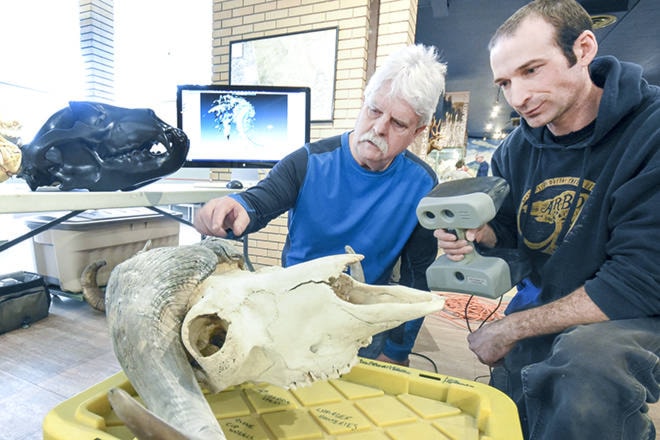When wildlife biologist-turned-artist Pat Field put his thinking cap on one day, the first thing that came to mind was the beauty of the skull, animal skulls in particular.
Pursuing his two passions in life, nature and sculpting, he hooked up with artistic counterpart Patrick Doratti of Nelson to begin down a less-travelled, creative path.
His current works include an enlarged, Chlorite raven skull and a 40-plus kilogram grizzly bear head with musk ox and wild sheep noggins presently in the works.
On Monday, Field and Doratti showed up at the with some examples of their work, a computer equipped with a laser scanner and what he thinks is a perfect way to intermingle art, technology and education in the wild.
“I’m a stone sculptor and we’re working with 3-D images of scanned skulls and producing them out of stone at a larger scale than the original,” said Field who worked for over 40 years in both public and private wildlife management. “And now this is an opportunity to create a relationship with the museums to see if we can build a story around the research, collection, display and education of the cultural things that are going on in nature.
“I’m really interested in getting kids, who don’t go out into the bush, interested in nature. We saw a huge opportunity here to start building this relationship with the museum as artists, to link up nature, art technology and economic development.”
The technology aspect that he knows will interest young people is the use of the 3D laser scanner which is where Doratti’s talents come in.
Doratti started out in animation school for a couple of semesters before becoming a traditional stone sculptor for 15 years.
After that, when he went to Carrara, Italy, famous for its marble quarries, he got involved with the robotics of carving, using machines which was something he eventually brought back to Canada.
At his Nelson studio he established a full robotics setup, imported from Italy, and using a computer numerical control (CNC) machine.
He first does a 3D scan of an object and uses the computer program with the machine to create a rough carving and returns it to artists like Field, who do the finishing work.
Doratti has clients from all over North America, although some who prefer not to be identified for professional reasons.
“It just really saves the artist a lot of time, because like the grizzly skull I get it digital and carve it out with the machine and give it back to Pat,” said Doratti. “In my opinion most pro artists use this method and have in some way since Michelangelo. The general public thinks of an artist as a virtuoso but it is very, very technical and mathematical. When someone asks me (if it’s not cheating) I say that’s just the romantic view of art.”
According to Field, the raven skull, involved two hours of scanning, six hours on the stone milling machine and 150 hours of polishing.
“So basically, about a month’s worth of work instead of several months,” said Field.
He also believes the computers scans can be turned into a living library.
“It can become a digital catalogue of nature, like a spruce cone or if some kid found a dead crayfish, we can scan that and start building those files,” said Field. “Those files can be used for a number of applications, for economic development, for artistic purposes or for medical purposes.
“Just like the collections they have now, our wealth comes from our natural capital that gives us our quality of life.”
And because I’m really interested in nature, it gives me all my inspiration for art is having this opportunity to show what it can actually to do.”
When he was approached by Field about the idea, museum curator Dennis Oomen was instantly intrigued about the concept and invited the artists for a demonstration.
“What Pat Field thinks and what I think has some promise for us as a museum and for natural history programming possibilities is the process itself,” said Oomen. “It is very interesting, it’s certainly groundbreaking and innovative. It’s on the cutting edge of what’s being done today in terms of 3D printing so we’re thinking this might provide an interesting thing for kids who get interested in technology and lead them on to a better appreciation of natural history and study of natural specimens.
“There’s a real possibility for the museum to develop new natural history programs out of this directed at kids and possibly adults.”
He feels that as the museum moves ahead into the future it needs to find new ways of presenting and interpreting artifacts from the past.
“And to me, this seems to be an interesting pathway to look at, and, Penticton has a good collection of skulls,” said Oomen.



